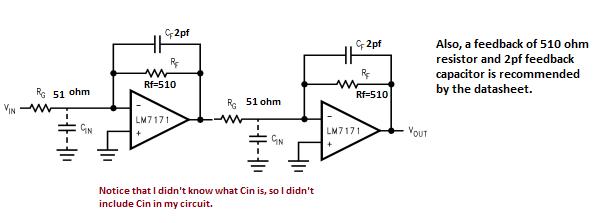I am currently working on an amplifier circuit for an 8MHz signal (around -40dbm.)
The amplifier is based on an IC chip (LM7171 bin).
The problem is, the amplifier works perfectly individually (correctly gives +20dB gain,) but when we cascade two of them together, it only amplifes +6dB in total.
It is supposed to give +40dB gain. It is probably not a problem of op-amp saturation.
Below is how we cascade our circuit. (VCC=15V, Vee=-15V)

The datasheet is here.
Decoupling capacitor is also connected between the source.
update:
For decoupling, I use 4 capacitors for each amplifier (Vcc=15V, Vee=-15V.)

Both op-amp work well individually (without connecting them together.)
When I meassured the midpoint between two op-amps, it gives +20dB gain. This circuit is on a breadboard.
Update2:
(Please note that this is not the circuit I have now, this is what I had before. Notice that in the picture, the two op-amps are not connected together. I can't take a photo of the current circuit because I don't have them with me. But the only change I make is simply connect them together and change the Rg value a little bit).

